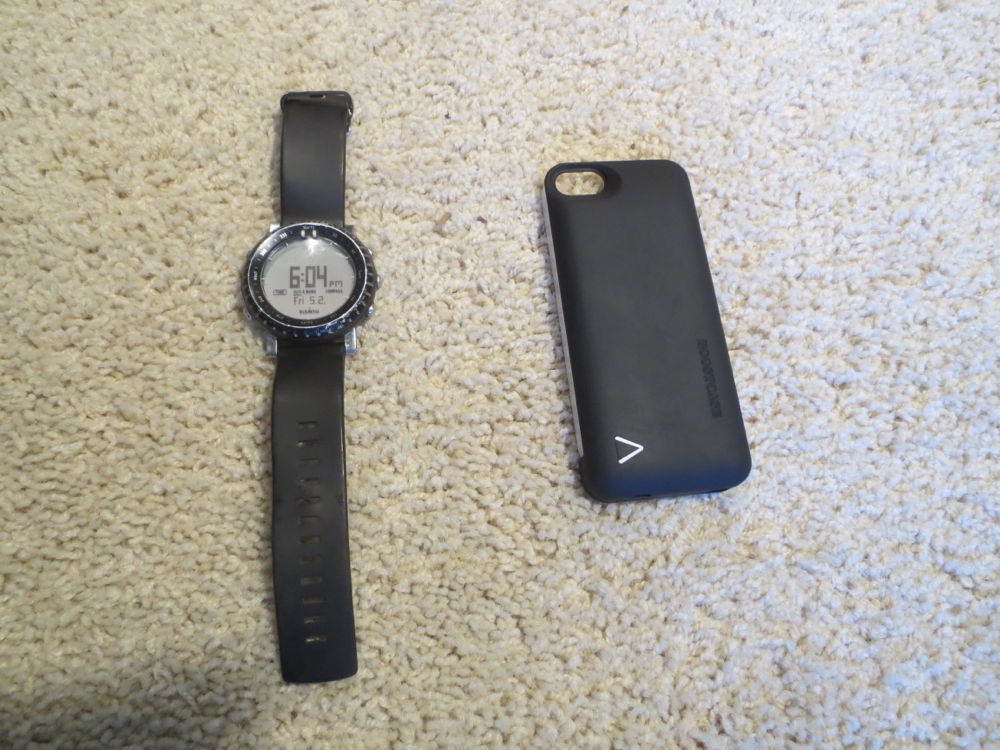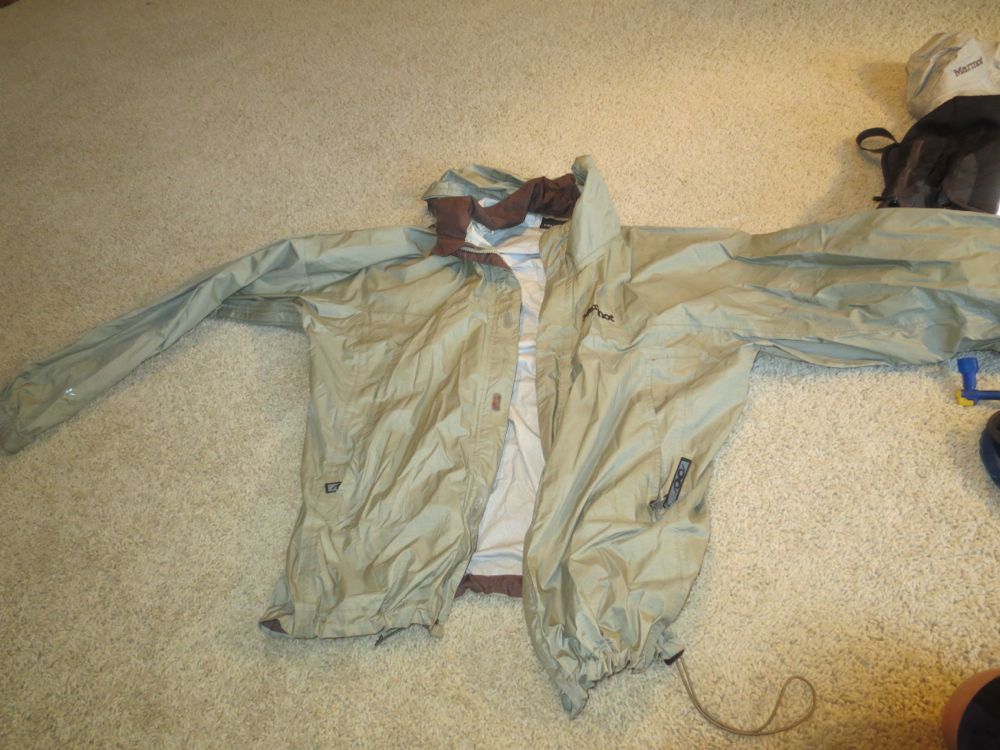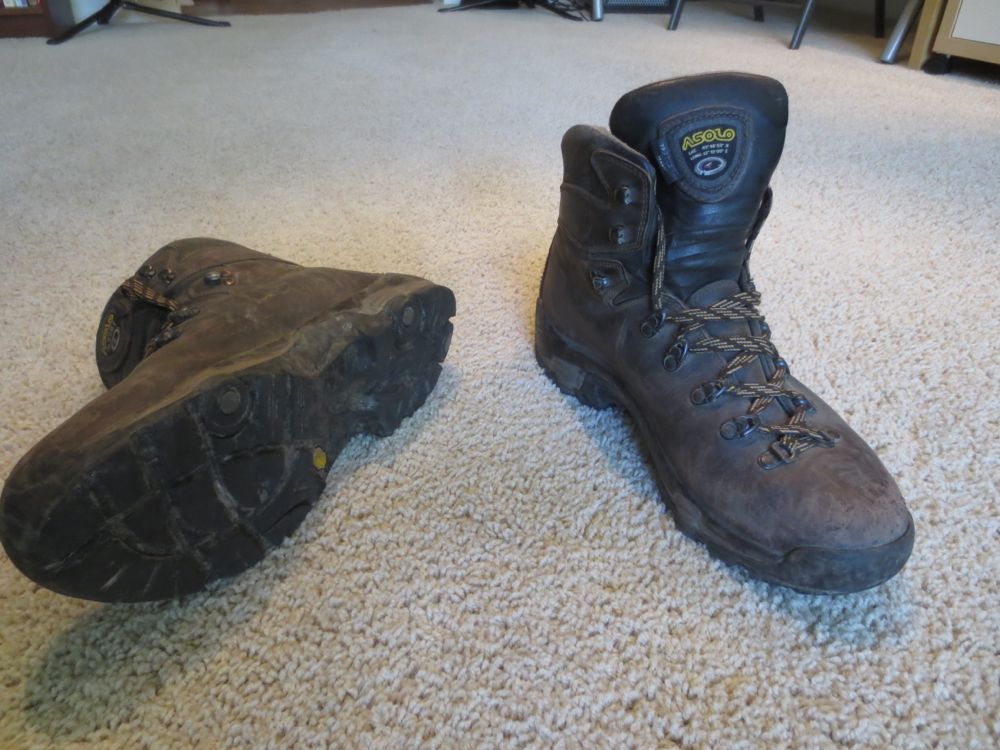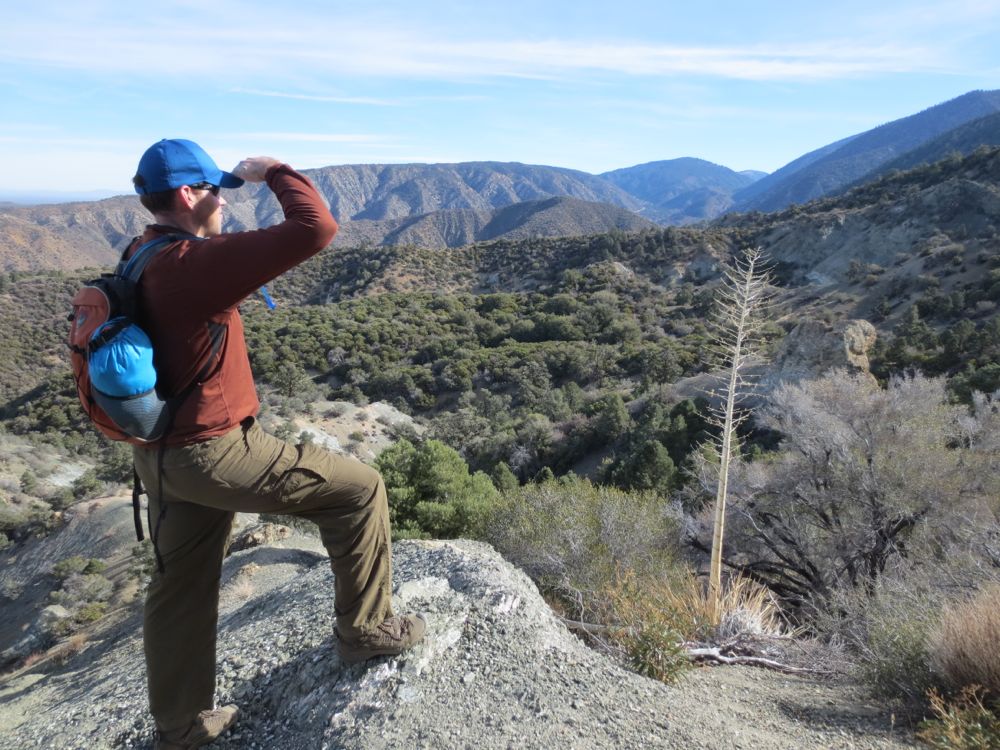
Hiking Gear – Hiking Clothing
If you have ever shopped for hiking gear, you probably realize at least one thing – there’s a lot of stuff to choose from! Here I attempt to describe the proper gear for the well-equipped day hiker, especially in Southern California. The key to hiking safety is preparation. It’s easy to believe that because you are just going on a day hike, or because you are in Southern California that you don’t need to think much about hiking gear. This is a dangerous and potentially fatal assumption. The wilderness in general, and especially tall mountain ranges, can be harsh and unforgiving environments.
Accidents and injuries do occur, and mountain weather can be unpredictable. However, by making sure you carry the proper hiking gear – especially The Ten Essentials – at all times, you can face challenges as they occur. Below I review the important items individually, and describe my own pack and its contents.


Day Pack
The best choice for day hiking is a day pack. These are typically 22 to 36 L in capacity. You can find many choices for Day Packs at REI. The best advice I can give is to go to the store and try on a bunch. The great thing about REI is that you can return items if you don’t like them, even if you have used it! Make sure to get a panel loader with lots of compartments – you’ll know exactly where everything is when you’re on the trail. You’ll also want both a chest strap and a waist strap to keep the pack securely on your body. Also make sure the pack holds a 3 liter(100 oz) reservoir. On hot days or long, tough adventure hikes, you can easily need all this water. You can always take less water in the larger reservoir on short hikes, but you can’t put more in smaller one.
The one I use, the Camelbak Blowfish, has unfortunately been restyled and now allows for only a 2 liter reservoir, so I would not recommend the current version. But you can see the approximate size and design from the photos, and there are many of similar size to choose from.
Camelbak makes great day packs, and I like the design of their 3 liter reservoir the best. They also guarantee it for life, and I have returned defective reservoirs and received new ones.
One of my hiking partners has had good luck with his Osprey pack though, so just try on a bunch at the store, buy one, and return it if it doesn’t work for you.



In the photo to the left you can see the surprising amount of hiking gear the pack can hold, and in the photo below the pack loaded with all the contents in the photo.
As you can see, a pack this size can hold everything you need for a day hike, and gear to survive overnight in an emergency if necessary.
The Ten Essentials
The history, logic, and current trends regarding key hiking gear items called The Ten Essentials is covered fully on the Hiking Safety page. Here I list them in order based on what I actually carry.
1) Navigation
Always carry a simple manual compass, even if you have a digital compass on your watch. I carry a simple Bruxton compass, and also use a Suunto Core watch with altimeter and compass, which I have had for four years now – it has been super reliable surviving immersion in streams, drops, banging, etc. In addition you need a map of your hiking area. Now that we have GPS devices, you can also use a standalone GPS device, or use an app on your smartphone.

I use GPS Kit, and all the GPX tracks on this site were created using this app. It only work on iOS right now but there are many other choices – do some research if you have an Android device. The item to the right of the watch is a Boostcase power case for iPhone. You will want a power case when using a GPS app on you smartphone because the app uses the GPS system on your phone continuously while you are hiking, and uses a lot of battery power.

2) Sun Protection
Always use and carry sunscreen and sunglasses with you. I use an SPF 30 waterproof sport lotion, but you should use whatever works best for your skin type – use a higher SPF factor if necessary. I keep the the larger bottle in my car to use before hiking, and keep the small tube in my pack at all times. The sunglasses are Bolle Grunt, which I don’t think they make anymore.
Don’t buy too expensive a pair because they tend to get lost or damaged, but I always buy a good quality sport pair because my eyes are worth it – you can decide for yourself. You can find good deals on these and other hiking gear items at Big 5 or a similar store from time to time.
3) Insulation (Extra Clothing)
This amount of extra clothing you carry is dependent on weather and your destination. At higher altitudes and in winter months it is more critical to carry additional items. I always carry the Marmot Precip jacket, which is a windproof and waterproof shell with a hood, that is very light and compressible. It can rain even in summer months in the mountains. Also, you should have convertible pants, so even if it is warm the pant legs should be in your pack. With these two items you are covered for most non-winter situations. These items also serve as protection – and are often necessary – if you are bush whacking. In addition a hat is a desirable item as additional sun protection for many people. If you are going into higher elevations or winter conditions, you should also carry other hiking gear like a winter hat, gloves, and a down jacket as well. All these clothing items are covered below in the clothing section.


4) Illumination
You should always carry a headlamp and extra batteries, My choice is the Black Diamond Spot. It’s a very versatile and reliable headlamp that I have used for years and have never had a problem. The Spot features multiple light levels and a very high powered spotlight if you need it.
5) First-aid Supplies
You should carry a lightweight first aid kit. The Adventure Medical Kits Ultralight .5 is a good choice for day hikers. I throw in a few additional items like ibuprofen, moleskin, iodine tablets, duct tape wrapped around a pencil segment (which can be used to make a splint or to wrap serious wounds), and extra band-aids. Also make sure to include any medications you might need.


6) Fire
You should always have a fire starter. I carry both a lighter and water proof matches. It is also recommended to carry a manual fire starter like a flint striker, which I do while back packing.
7) Repair kit and tools, including knife
Always carry a good quality pocket knife in your pack. In addition, the duct tape wrapped around a pencil segment – shown in the photo above – also serves as a repair material that can be used in many situations.
8) Extra food can be some bars or nuts, and also some energy chews or gels.
Make sure to carry something beyond what you will consume on your hike. If you are injured and have to spend the night out the extra food performs several functions – it increases your metabolism thus generating body heat, it stabilizes your blood sugar thus helping with shock, all of which make you feel better and think more clearly in a dramatic situation.
9) Hydration (Extra water)
In addition to the water you carry with you, which should be more than you plan to drink, you should also have a means of treating water in case you run out. The Sawyer water filter shown in the photo is a great choice because it is super light. You can also carry iodine water treatment tablets.
10) Emergency Shelter
There is a little known item that all hikers should carry – an emergency bivy sack. The one shown is super small, light, and cheap so there is no excuse not to carry this with you at all times. It might save your life, or at least make the difference between a very uncomfortable night in the cold or a tolerable night until you are rescued.

Hiking Footwear
This is perhaps the most important piece of gear. Again there are many choices. Try on a bunch – you can’t try on too many! When I started hiking I was at my local REI and other stores constantly walking around with different shoes and boots on.
I typically wear trail runners on many hikes now, especially in warmer weather or for adventure hikes in streams where I know I will get wet. These shoes dry quickly and provide greater agility for boulder hopping. Make sure to get a pair of real trail runners, of which there are relatively few. Most shoe manufacturers use a running shoe and modify it slightly, call it a trail runner and charge you more. Solomon, New Balance, Montrail, and Brooks make real trail runners.
I have had good luck with Salomon and New Balance, particularly because I have wide feet and they offer these shoes in a wide width. The NB Leadville 1210 are pictured here.
I also own light hikers, which have a high top and offer much more support. I used to wear these all the time, and still like them for many hikes. Many people prefer boots and if you’re not sure buy a light hiker – you can always go to a trail runner as you get more advanced, or for different types of hikes that require more agility. My favorite in this category are the Merrell Moab Ventilator. These are great if the weather is cooler, if you’re in light snow, and also if you are on a very rocky trail they help keep the gravel out of your shoes because of the high tops. But they are good in warm weather because they’re not too heavy, and there is also virtually no break in period in my experience. But there are a large number of good boots, so just try on every pair you can!


In addition, I have a pair of classic mountain hiking boots, the Asolo TPS 520. These are a time-tested design with full leather and thick soles, and are suited for backpacking, cold temperatures and snow conditions, and more serious mountaineering. They also come in a wide size for those who require this option. I would not recommend to buy this type of boot as your primary shoe as a day hiker in Southern California – they are too hot and heavy for most hikes you will be doing here.
With the three above you are covered for any season in Southern California, but if you are not going to hike in serious snow conditions you will be fine with both or either of the trail runner and/or light hiker. Note that all three of the shoes pictured feature Vibram soles – in my experience this is the best material for grip on wet surfaces and if you have a choice get a shoe with a Vibram sole.
Hiking Poles
These are useful in many situations, and some of my hiking partners use them on almost every hike. They are, however, essential for backpacking to keep you balance with a heavy pack, so you should have a pair anyway. We typically use only one pole for hiking, because with a light pack that’s all that’s necessary, and trying to use two actually becomes a bit clumsy. Hiking poles can also help if you have knee or hip problems since they help relieve some stress off these joints. Make sure to buy a good quality pair, as they will last a long while, and the very cheap ones might fail you at a bad moment. The cheap ones are also heavier, and this makes a difference after hours on the trail. A snap lock is better than a twist lock, as they are easier to use. There are many different types, and as always, check them out at REI or another store to see which works best for you. I have had great experience with the Black Diamond Trail Back poles, which cost about $80.
Hiking Clothes
Having made sure now that you have a good pair of hiking shoes, you now need to think about your other clothing items. (No, you can’t normally hike in just shoes.) The way to think about clothing for hiking, and any outdoor activity, is in terms of a layering system.
For your top – your base layer is a synthetic fabric shirt, on top of that a mid-layer of a fleece shirt, on top of that a light down jacket, and on top of that a waterproof technical shell. For your bottom – a base layer of polyester long johns, and a pair of hiking pants, and in rare cases maybe a pair of waterproof pants if you are snowshoeing or something like that. In cold conditions you will want a hat and gloves as well.
Here in Southern California you will not very often need all of these, but you should have them if you are going to be a year round hiker. You will also need them if you are thinking about back packing. Usually for Southern California day hikes you will need only the hiking pants/shorts, a t-shirt, and a rain shell for your extra clothing and for bush whacking.
You will want to invest in a good quality pair of convertible pants. These have zippers on the legs at just above knee height so they can be work as pants or shorts. If it’s a warm day you can keep the pant legs in your pack in case you get to a higher elevation or into a dark canyon where it might be windy or cooler. If it’s a cool day you can always take them off after you warm up while hiking, or later in the day as the temperature increases or the sun comes out. Another important reason to have these is in case you want to do any of the adventure hikes on this site. For most of these you will want to have your legs covered to limit cuts and scratches from brush, and also to avoid exposure to poison oak or stinging nettles.
For these pants I would recommend to spend the money and stay with an outdoor clothing manufacturer like Mountain Hardware, North Face, REI, etc., since the cheaper brands don’t last and the zippers are of poor quality.
As for your shirt – and other clothing as well – make sure to avoid cotton! Cotton is a poor fabric for any hiking clothing. It completely loses its breathability when wet, so after you perspire for a while and your shirt gets wet or you are in water like an adventure hike in a stream, it will not wick moisture away from your body. It also drys much more slowly, so you will stay wet and clammy all day. Choose synthetic fabrics like polyester. Wool is a good choice as well as long as you are not too sensitive – it doesn’t work for me as I always find it itchy.
I find that the simple hiking t-shirts designed by the large outdoor clothing companies are over priced. Everlast and Champion make decent quality, cheap shirts that wear well. For a fleece shirt you can also find them much cheaper if you look around, as the outdoor clothing companies charge too much for these as well.
Socks are another personal choice, but I have had good luck with Thor-lo Hiking socks for the light hiker boots or heavy boots, and with Wrightsock for the trail runners. In addition, Champion makes a decent, cheap crew sock that can be used with the trail runners.
A lightweight technical shell that is windproof and waterproof is a must. This is one you will use year round in a variety of conditions. Many manufacturers produce them, and for this item you should buy from an outdoor company because the waterproofing is more reliable, and they are lighter and more compressible. I use the Marmot Precip which has served me well for years.
You will also want a lightweight down or down alternative jacket. These can be purchased from a number of sources, but this is another item for which you should buy a good lightweight one from an outdoor manufacturer. They are much lighter, and importantly, more compressible so they fit in your pack. You will need this item if you want to go up into the mountains in winter conditions – and they are so beautiful after a newly fallen snow!

I hope this primer on hiking gear was helpful. Feel free to leave a comment below or send an email via the contact us link if you have any questions. Until we meet on the trails, get out there and enjoy our magnificent natural world!







